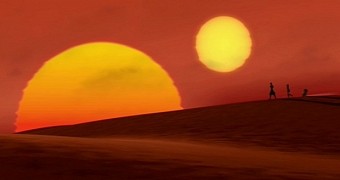Having carried out a series of mathematical simulations, scientists at the University of Utah in the US found evidence that the cosmos is probably populated by an army of Earth-like planets similar to Tatooine, Luke Skywalker's home in “Star Wars.”
When saying that these planets resemble Tatooine, the researchers mean that, unlike Earth, they orbit not one, but two stars. Consequently, twin sunsets and twin sunrises are visible from their surface.
The thing is that, so far, no such rocky worlds have actually been spotted orbiting a binary star system. As mentioned, it is purely based on mathematical simulations that the University of Utah team of scientists postulate their existence in the universe.
How planets form from debris around young stars
In a report detailing their work, the researchers behind this investigation explain that, much like the dust bunnies that form under our beds when teeny tiny particles of dirt clump together, planets form from gas and debris circling a young star.
The planets until now identified around binary systems are all gas giants, and some scientists are convinced that the conditions around such twin stars do not allow for the formation of rocky Earth-like celestial bodies.
The University of Utah researchers disagree and say that, provided that it forms in the just right orbit to avoid collisions with other orbs and to keep safe from being torn apart by the gravitational pull of its parent stars, rocky planets can form in the proximity of binary systems.
“If the planetesimals [build-ups of dust, rocks and other materials] are in an oval-shaped orbit instead of a circle, their orbits can be nested and they won’t bash into each other. They can find orbits where planets can form,” details astrophysicist Ben Bromley.
“It is just as easy to make an Earth-like planet around a binary star as it is around a single star like our sun. So we think that Tatooines may be common in the universe,” the specialist goes on to explain.
Well, why haven't we found such Tatooine planets yet?
Since it was launched on March 7, 2009, NASA's Kepler space telescope has zoomed in on well over 1,000 stars. Of these, merely 7 sit either close to or smack in the habitable zone of a binary star system, and they are all gas giants.
Scientist Ben Bromley and fellow researchers suspect that the reason we have not yet discovered rocky planets orbiting binary systems is simply that, being way smaller than their gassy siblings, they are fairly difficult to spot.

 14 DAY TRIAL //
14 DAY TRIAL // 

